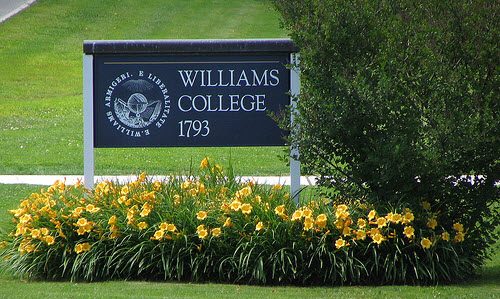
Photo by: SERSeanCrane. Retrieved from: www.flickr.com
Williams College is a school that welcomes students from all walks of life. This idyllic college is steeped in history and tradition, and boasts a vibrant student life and excellent faculty. It is a highly selective school, as the student acceptance rate is among the lowest, at less than 17 percent of all applicants. Even so, many high school seniors dream of going to Williams; for good reason.
All accepted students enjoy the benefit of being in a college with a faculty:student ratio of 1:7, with the majority of faculty members holding terminal degrees in specialized subject areas. The school is managed well, with excellent security for student houses.
The college is made up of three divisions, including: Arts and Languages, Social Studies, and Science and Math. One academic year consists of two semesters and one winter term held during January.
School History
Williams College was established in 1793, making it one of the oldest colleges in the country. The school was founded with the help of Colonel Ephraim Williams, the college’s main benefactor. Colonel Ephraim Williams, who died in the battle of Lake George in 1755, left a great sum of money for the development of a free school in the town, then called West Hoosac, Massachusetts. The condition was that the name of the town be modified to Williamstown. The sports team of Williams College, which plays in the NCAA III athletic conference, is named “Ephs” in honor of the original benefactor.
Williams was the site of one of the most significant prayer meetings in history. In 1806, several Williams students met to pray in the Sloan’s meadow when a thunderstorm hit the area and they were forced to seek shelter under a haystack. This momentous meeting gave rise to the first American institution to send missionaries overseas. A monument was erected in Mission Park to commemorate this event.
Like many of the schools founded before the 1900s, Williams was originally an exclusive school for boys. But in 1970, the school opened its doors to female students.
Campus Life
The rural landscape of Williams leads to a unique and special school experience for successful applicants. Students attend small classes, often with fewer than twenty students per class. Students enjoy the peaceful environment, hiking around the campus and in the main street of Williamstown, and the close proximity of the housing clusters. More than ninety percent of the students live in clusters of homes that are affiliated with, operated by or owned by the college itself. The rest (less than 10 percent) live off campus. The cluster housing system in Williams College, which includes six residence halls, has its pros and cons. On one hand, students develop a sense of community by belonging to neighborhoods along with other student residents, fostering good life-long relationships among students. On the other hand, the housing choices are limited.
Although collegiate fraternities have been abolished in the early 1960s, there are many interesting activities that students can join, such as the annual hike in October that involves a massive group mountaineering trek in Mount Greylock.
The student services are many and varied, and not limited to academic services like non-remedial tutoring. The college takes safety and security around the campus seriously. The sidewalks and trails around the campus and the residential areas are lighted and there is a late night escort and transport services. Security personnel patrol the grounds 24 hours a day and an emergency number is available for students and faculty. Dormitory access is limited to residents, who receive their own key and security card upon acceptance to a housing facility. Although many of the students prefer to walk to their classes, around 30 percent of the student population uses automobiles.
Financial Aid
The strong financial aid program is one of the many unique things that this college has to offer. Successful applicants for admission can get generous need-based scholarships and grants, as well as self-help aid. Approximately 60 percent of the students receive financial aid, the amount and form of which depend upon their needs.
